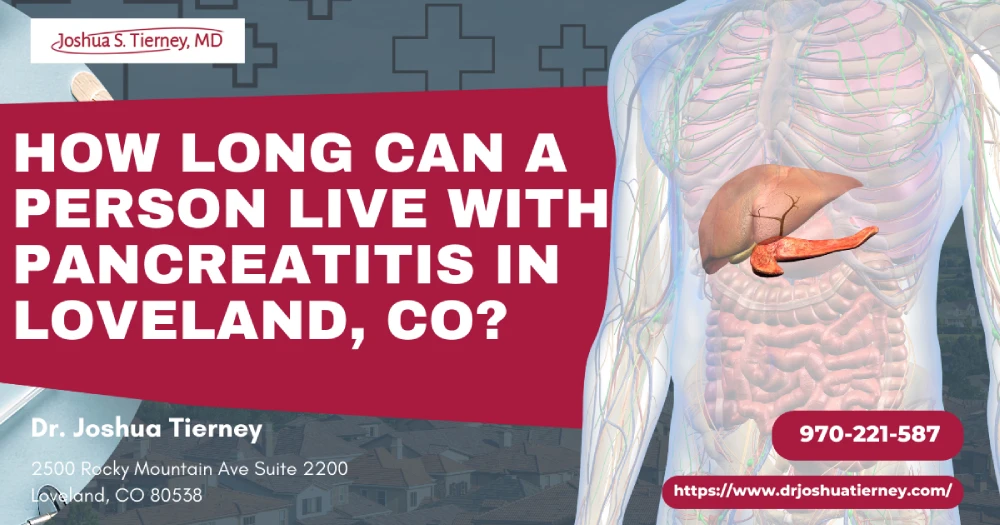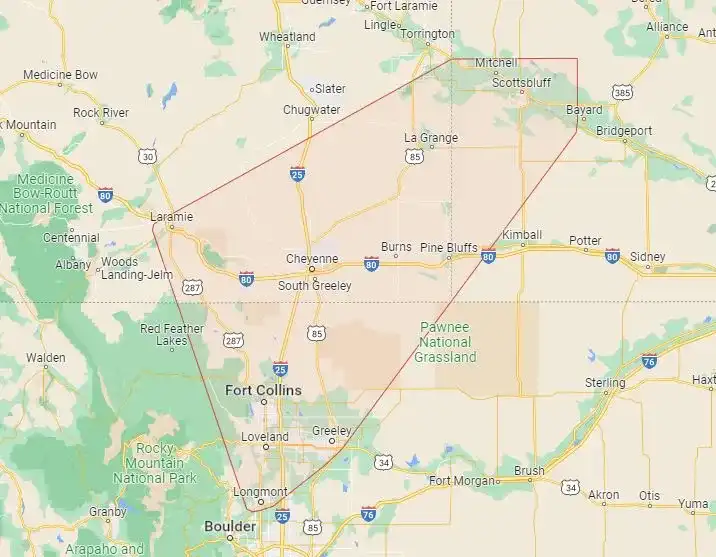In Loveland, the life expectancy of someone with pancreatitis varies enormously, hinging on whether the condition is acute pancreatitis, recurrent acute, or chronic pancreatitis, as well as on overall pancreatic health. Acute cases usually heal, and many patients regain full function of the pancreas. Yet severe acute pancreatitis with multisystem organ failure can threaten life within days.
Chronic pancreatitis is a longer story; the 10-year survival rate is roughly 70 percent, while 20-year figures fall to about 45 percent. Though not always fatal, chronic inflammation of the pancreas can erode quality of life, hamper the digestive system, and increase the risk of pancreatic cancer.
Local data show survival improves when patients receive high-quality care early—from experienced gastroenterologists, surgeons, and pain specialists practicing in Loveland or neighboring Fort Collins.
Key Takeaways
- Early diagnosis is critical.
- Severity drives life expectancy.
- Lifestyle choices play a huge role.
- Specialized, multidisciplinary care is available locally.
- Quality of life can be protected with the right tools.
- Regular monitoring lowers cancer risk and detects complications such as pancreatic duct strictures, abscess, or splenic vein thrombosis.
Understanding Pancreatitis Types and Severity in Loveland
Pancreatitis is not a single disease. It represents a spectrum that ranges from a self-limited bout of acute pancreatitis to progressive chronic pancreatitis with permanent scarring inside the gland. Knowing precisely which form you face helps predict prognosis, guide pancreatic surgery decisions, and shape day-to-day pain management plans.
| Pancreatitis Type | Common Aetiology | Key Symptoms | Short-Term Risk | Long-Term Impact |
| Mild Acute | Gallbladder stones, high triglycerides | Upper-abdomen pain, nausea | Low mortality | Minimal once healed |
| Severe Acute | Alcohol binge, bile duct obstruction | Intense pain, organ failure | Up to 30 % mortality | Possible necrosis, abscess |
| Chronic | History of chronic drinking, genetic mutations, stones in the pancreatic duct | Persistent pain, steatorrhea | Moderate | Lower 10- & 20-year survival |
Acute vs. Chronic—A Quick Comparison
An acute attack often follows a fatty meal, gallstone migration, or binge drinking. Imaging such as computed tomography (CT) or magnetic resonance imaging (MRI) shows swollen tissue within the pancreas but little scarring. By contrast, chronic pancreatitis features calcifications, strictures in the pancreatic head, and dilated ducts. Repeated inflammation gradually destroys exocrine cells of the pancreas, leading to malabsorption, weight loss, and sometimes diabetes mellitus.
Local Snapshot: Loveland & the Front Range
Colorado’s hospitalization rate for pancreatic diseases is modestly lower than the U.S. average, yet alcohol-related admissions remain frequent along the Front Range corridor—from Loveland to Fort Collins and Greeley. Public-health reports reveal that roughly 1.6 percent of adults here report weekly heavy drinking, a clear risk factor for recurrent acute episodes and reduced survival rates.
Factors That Influence Your Life Expectancy
Every pancreatitis story develops differently, but several themes keep surfacing in clinical studies.
Medical Complications
- Necrotizing pancreatitis, infected pseudocysts, or a pancreatic abscess can dramatically shorten lifespan.
- A stricture in the common bile duct may raise jaundice risk and trigger cholangitis.
- Development of pancreatic exocrine insufficiency, diabetes, or pancreatic adenocarcinoma worsens overall prognosis.
- A family history of chronic inflammation increases the risk of developing exocrine pancreatic cancer at a younger age.
Personal Risk Factors
- Alcohol & Tobacco: Each drink or cigarette heightens pancreatic inflammation and cancer risk.
- Diet & Weight: Chronic high-fat intake or obesity elevates triglycerides, precipitating acute attacks.
- Genetics: PRSS1, SPINK1, and CFTR mutations raise the lifetime risk of pancreatic diseases.
- Previous pancreatic surgery: Operations that remove the head of the pancreas or the tail can alter enzyme flow and digestion.
Managing Acute Pancreatitis: A Path to Full Recovery
Even severe acute cases can end well if care is delivered quickly. Emergency departments in Loveland initiate IV fluids, pain control, and early nutritional support—often feeding through the duodenum to rest the gland. Endoscopic retrograde cholangiopancreatography (ERCP) may extract gallstones lodged in part of the bile duct, halving recurrence rates. CT-guided drainage deals with fluid collections and avoids open surgery in many patients.
Recovery Timeline & Follow-Up
Most mild attacks resolve within a week. After discharge:
- Arrange a CT scan or MRI 4–6 weeks later to confirm no residual necrosis.
- Re-introduce low-fat foods; consider medium-chain triglyceride oil for calories that do not overwork the pancreas.
- Avoid alcohol forever—strict abstinence improves five-year survival by as much as 20 percent.
Living with Chronic Pancreatitis: Improving Quality & Longevity
A chronic diagnosis can feel daunting, yet many residents continue to hike local trails or cycle the Loveland-Fort Collins bike paths. Survival and life satisfaction soar when patients combine medical therapy, nutrition, minimally invasive procedures, and psychosocial support.
Pain Management Strategies
- Enteric-coated pancreatic enzymes reduce ductal pressure and post-meal discomfort.
- Low-dose tricyclic antidepressants, pregabalin, or duloxetine calm neuropathic pathways.
- A celiac plexus block or radiofrequency ablation can address pain that radiates to the back or upper abdomen.
Enzyme Replacement & Nutrition
Pancreatic enzyme replacement therapy (PERT) is pivotal once fecal elastase falls. Loveland dietitians recommend:
- 5–6 small, low-fat meals spaced evenly across the day.
- 1–1.5 g protein/kg body weight to support tissue repair and muscle mass.
- Fat-soluble vitamin supplements (A, D, E, K) to correct malabsorption.
Surgical & Endoscopic Options
- Pancreaticojejunostomy (Puestow) drains a dilated pancreatic duct and relieves pain in select cases.
- Distal pancreatectomy removes the tail of the pancreas along with the spleen and splenic vein when disease localizes distally.
- A Whipple procedure—removal of the head of the pancreas, part of the small intestine, and portion of the bile duct—may be required for pancreatic cancer diagnosis or high-grade dysplasia.
- Total pancreatectomy with islet autotransplantation offers pain relief and can prevent brittle diabetes by relocating insulin-producing cells.
Screening & Surveillance: Staying One Step Ahead
People with chronic pancreatitis or a long history of pancreatic inflammation have an elevated risk of pancreatic neuroendocrine tumors and exocrine pancreatic cancer. Surveillance often includes:
- Annual or biennial magnetic resonance imaging with MR-cholangiopancreatography.
- EUS (endoscopic ultrasound) for small pancreatic cysts or a questionable mass behind the stomach.
- Tumor markers like CA 19-9, although nonspecific, may reveal early pancreatic adenocarcinoma when trending upward.
Early detection matters—stage-I pancreatic cancer has a five-year survival near 40 percent, compared with single-digit figures for advanced disease.
When to Seek Medical Help in Loveland
Red flags indicating you should call 911 or go to the closest emergency department include:
- Sudden, relentless pain in the upper abdomen radiating to the back.
- Vomiting blood or passing tar-colored stools.
- Fever above 101 °F with shaking chills, suggesting infected necrosis.
- Dizziness, confusion, or shortness of breath—possible signs of systemic inflammatory response.
Patients already diagnosed with pancreatitis should maintain a rescue plan with their gastroenterologist. Poudre Valley Hospital and Medical Center of the Rockies both offer 24/7 CT scans, interventional radiology, and advanced ICU care.
Supporting Your Journey: Lifestyle, Mental Health, Community
Longevity with pancreatitis requires caring for body and mind. Small, daily choices reduce flare-ups, enhance prognosis, and improve overall happiness.
Alcohol & Tobacco Cessation
Local cessation clinics provide nicotine-replacement therapy, varenicline, and counseling. Quitting reduces acute attacks, improves circulation around the pancreas, and lowers cancer risk.
Anti-Inflammatory Diet
- Emphasize lean proteins (turkey, fish), whole grains, and colorful produce.
- Limit fat to 30 g a day during flare periods; gradually liberalize under dietitian guidance.
- Stay hydrated—eight to ten glasses of water or electrolyte drinks keep pancreatic juice flowing and prevent ductal plugs.
Exercise & Stress Control
Light cardio—walking around Lake Loveland, for instance—lowers triglycerides, improves bowel motility, and enhances mood. Mindfulness practices curb the stress-pain cycle common in chronic disease.
Community Support
Northern Colorado Pancreatitis Support Group meets monthly; sharing recipes and coping strategies can fight fatigue, anxiety, and feelings of isolation.
Prognosis in Perspective
Pancreatitis does not come with a single timetable. Mild acute attacks often resolve completely; severe or chronic forms demand life-long vigilance. By embracing early diagnosis, optimized nutrition, minimally invasive procedures, and consistent follow-up, patients can surpass average survival rates and reclaim meaningful activities—from fishing at Boyd Lake to enjoying downtown Loveland art walks. Talk with your healthcare team today about the next steps; every proactive decision you make adds life to your years and years to your life.
FAQs
What is the difference between pancreatic inflammation and a pancreatic infection?
Inflammation of the pancreas is the body’s response to injury or irritation—think swelling, redness, and pain. A pancreatic infection means bacteria have entered necrotic tissue or fluid collections, forming an abscess. Infection raises the danger level and often necessitates antibiotics, CT-guided drainage, or surgery.
How does a poor diet increase the risk of developing chronic pancreatitis?
High-fat, highly processed foods elevate triglyceride levels and can trigger acute attacks. Repeated episodes scar the pancreatic duct, reduce enzyme output, and set the stage for chronic disease. Adopting a balanced, low-fat meal plan lowers recurrence and supports a healthier digestive system.
Are pancreatic cysts always a warning sign of cancer?
Most cysts—especially small serous types—are benign. However, mucinous cysts and intraductal papillary mucinous neoplasms carry cancer risk. Your doctor may recommend MRI, EUS, or surgical treatment depending on size, symptoms, and cytology results to prevent malignant transformation.
Can endoscopic retrograde cholangiopancreatography treat strictures in the pancreatic duct?
Yes. ERCP allows specialists to dilate strictures, place stents, and remove stones in the pancreatic duct. These minimally invasive measures improve enzyme flow, reduce pain, and may delay or prevent major surgery in properly selected patients.
How reliable are CT scans for diagnosing acute pancreatitis complications?
Contrast-enhanced CT identifies necrosis, abscess, and fluid collections with high accuracy, guiding treatment. Timing matters: imaging too early may underestimate damage; waiting 48–72 hours after symptom onset often provides the clearest picture.
Does pancreatic surgery guarantee pain relief in chronic pancreatitis?
Surgical procedures such as pancreaticojejunostomy or Whipple can deliver substantial pain reduction when medical therapy fails, but results vary. Success depends on disease location, surgeon expertise, and whether nerve pathways have become centrally sensitized.
What role does the spleen play in distal pancreatectomy outcomes?
Removing the tail of the pancreas often involves taking out the spleen and splenic vein. Loss of the spleen can slightly raise infection risk, so patients typically receive vaccinations against pneumococcus, meningococcus, and Haemophilus influenzae before or after surgery.
How does a family history of pancreatic cancer influence screening protocols?
First-degree relatives of patients with pancreatic adenocarcinoma face a higher lifetime cancer risk. Experts may begin MRI or EUS surveillance 10 years earlier than the age at which the relative was diagnosed, aiming to detect lesions when surgical cure is still possible.
Can pancreatitis in the pancreatic head affect the duodenum or bowel?
Yes. Severe inflammation in the pancreatic head may compress the duodenum, slowing gastric emptying and causing nausea or vomiting. Scar tissue can also narrow the common bile duct, leading to obstructive jaundice that may require stenting or surgery.
What pain-management options exist if opioids are no longer effective?
Multimodal strategies help: pancreatic enzymes ease postprandial pain, nerve blocks address specific pathways, and low-dose antidepressants modulate central processing. Comprehensive pain clinics in Loveland coordinate physical therapy, cognitive-behavioral therapy, and medication adjustments to restore function without escalating opioids.









